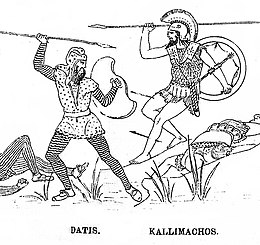Datis
Datis | |
|---|---|
 | |
| Native name | *Dātiya- |
| Born | Media, Achaemenid Empire |
| Allegiance | Achaemenid Empire |
| Battles/wars | Ionian Revolt |
Datis or Datus (Greek: Δάτης, Old Iranian: *Dātiya-, Achaemenid Elamite: Da-ti-ya[1]), was a Median noble and admiral who served the Persian Empire, under Darius the Great. He was an expert in Greek affairs and maintained connections with Greek officials.[1] He is noted for his joint leadership with the younger Artaphernes of the Persian forces in the first campaign of the Persian Wars against the Greeks. His earlier career is not known.
Biography[]
Before the Persian Wars Datis was a Persian commander during the Ionian Revolt. Datis would lead the counter-offensive against the Ionians during the revolt in 494 BCE.[2]
Datis and another officer named Artaphernes replaced a commander named Mardonius. Datis was ordered to reduce Athens and Eretria to slavery, and bring the slaves before the kings. The goal of Datis' campaign was to establish a bridgehead in the eastern coast of Greece.
In 490 BCE, Datis sailed of the Ionian shoreline to Samos, and then he traveled eastward through the Icarian sea to the islands of Delos and Naxos.[3] When Datis arrived the inhabitants of the islands fled. Datis then sent the inhabitants a message telling them he would never harm the islands. Datis would also burn large amounts of incense at the altar of Apollo. This piece of propaganda resulted in the Oracle of Delphi becoming a mouthpiece for Persian propaganda. [4]
Datis traveled across Greece taking town after town for the Persian Empire. One town named Carystus resisted Datis. Because of this Datis laid siege to the city. Datis began the siege by destroying the crops around the city. Datis' army of 80,000 soldiers with 200 triremes overwhelmed the city causing Carystus to surrender.[4][5]
During Datis's siege of Eretria in 490 BCE, the Eretrians had many conflicting strategies. Some Eretrians wished to surrender the city and wage guerrilla warfare in the mountains of Greece. Some Eretrians wanted to betray the city to the Persians. 4,000 Athenian colonists came from Chalcis to defend Eretria. Datis attacked the Eretrians in battle, resulting in severe casualties. On the seventh day of the siege the Eretrians surrendered, and all of the temples in the city were burned to enact revenge on the burning of Sardis.[4] It is very likely one of the temples destroyed was the temple of Apollo Daphnephoros.[6]
He would also command the Persian assault force on the Athenians at the Battle of Marathon in the same year. Ctesias of Cnidus relates that Datis was slain at Marathon and that the Athenians refused to hand over his body,[7] however this conflicts with Herodotus' earlier claim that Datis survived the battle [8]
If Datis survived the battle of Marathon he would have returned to Asia and returned the statue of Apollo to Delos and he would have taken his Eretrian slaves to Susa.[8]
Family[]
An Athenian statesman named Aristides was accused of being the brother of Datis.[6] Datis also had several sons named Harmamithres and Tithaeus. Both of his children would become cavalry officers under Xerxes I.[8]
References[]
- ^ a b "Welcome to Encyclopaedia Iranica".
- ^ Souza, Philip de (2004). The Greek and Persian Wars 499-386 BC. Taylor & Francis. ISBN 978-113-588-209-9.
- ^ McNab, Chris (2018). Greek Hoplite Vs Persian Warrior: 499–479 BC. Bloomsbury Publishing. ISBN 978-147-282-573-5.
- ^ a b c Green, Peter (1996). The Greco-Persian Wars. California: University of California Press. ISBN 978-052-091-706-4.
- ^ Shirley, Samuel (2003). On the War for Greek Freedom: Selections from The Histories. Hackett Publishing Company, Incorporated. ISBN 978-160-384-679-0.
- ^ a b Garland, Robert (26 January 2017). Athens Burning: The Persian Invasion of Greece and the Evacuation of Attica. Johns Hopkins University Press. ISBN 978-142-142-195-7.
- ^ Photius the Great, Excerpts of Ctesias' "Persica", Paragraph 22, available online at https://www.livius.org/ct-cz/ctesias/photius_persica.html
- ^ a b c Herodotus, Histories
External links[]
- Admirals of the Achaemenid Empire
- 5th-century BC deaths
- Median people
- Persian people of the Greco-Persian Wars
- Battle of Marathon
- 5th-century BC Iranian people
- Generals of Darius the Great
- Middle Eastern military personnel stubs
- Ancient Near East people stubs